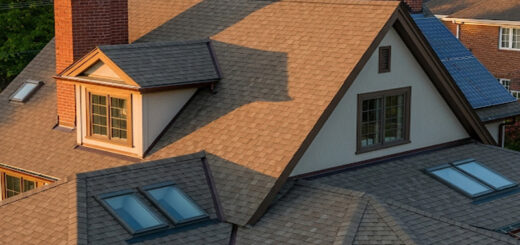Which materials are best for flat roofs?

There are many different types and sizes of roofs. Depending on how many penetrations, dormers, and other features they have, they can differ widely.
The slope of a roof is one of the biggest differences between them. There are roofs with steep slopes, roofs with multiple slopes, and even roofs with a completely flat surface.
This blog explains how to calculate the slope of your roof and how you can use it to measure your own!
There are different types of roofs, and you’ll need different materials to cover them. A steep slope roof makes it easier for water to run off of residential buildings. Asphalt shingles are often used for these kinds of roofs, because they are less expensive than metal and provide a better look than flat roofing.
A lot of roofs have a very low slope, or none at all. Roofing materials such as asphalt shingles cannot be used on this kind of roof. On a sloped roof, shingles form a cohesive unit, but water can seep through the points where they meet if water sits on them too long.
For these flat roofs, what kinds of materials are available?
EPDM (ethylene propylene diene terpolymer)
TPO (thermoplastic polyolefin)
Modified Bitumen
PVC (polyvinyl chloride)
BUR (built-up roof)
Standing Seam metal
EPDM Rubber Roofing Material
A rubber material known as EPDM (ethylene propylene diene terpolymer) is usually applied to roofs using an adhesive to protect them from the elements. It is a black rubber material made from ethylene propylene diene terpolymer. Though it’s still called EPDM because of how it used to be made, today’s EPDM is made terpolymer with three monomers.
The most common uses of this type of roof are on commercial buildings where reflections may be a problem. Unlike EPDM, which is black, the other membrane roofs on this list are white and reflect a great deal of light, creating intense glare. It’s pretty important for helicopter pilots to see where they’re landing when landing in hospitals, so EPDM roofs will be the best choice.
The longevity of EPDM membranes makes them a great choice for flat roofs, since they can last up to 30 years or more.
TPO Roofing Material
An all-weather, single-ply thermoplastic polyolefin membrane with a white reflective coating is known as TPO (thermoplastic polyolefin). Because of that coating’s ability to reflect heat, the area below it will stay cooler for longer. EPDM and PVC have long been the kings of flat membrane roofs, but TPO is making some noise of its own.
The TPO flat roofing material is quite cost-effective and lightweight, making it much easier to install than some of its competitors. It is, however, difficult to find a professional who can repair it correctly and without much effort because of its newness.
TPO also shows dirt fairly quickly, so you may not want to use it over areas you’ll be looking at frequently.
PVC Roofing Material
There has been a long history of PVC (polyvinyl chloride) membranes. Flat roofs are a popular choice, especially for buildings that want to keep space below them cooler, and don’t need to worry about glare from the roof.
Flat Roof Repair_WebP
If installed properly, they can last 30-40 years and are very resistant to fire, hail, and wind damage. As with TPO, PVC membranes are pretty easy to install, since they come in rolls and don’t require much weight to hold them down.
Furthermore, their reflective coating helps keep costs down during hot weather by reducing AC costs by keeping the sun’s heat out.
Modified Bitumen Roofing Material
Asphalt is the primary component of Modified Bitumen roofs, another rolled membrane roofing system. The construction is similar to three-tab asphalt shingles, but is more flexible, and has an additional waterproofing layer.
As this material is self-adhesive on the bottom and doesn’t have seams, it’s significantly easier to install than the other materials. It’s much easier to match modified bitumen roofs to the color scheme of your building than other flat roofing types that only come in white or black. As a result of those reasons, this material is pretty popular among homeowners for flat roof sections.
It usually takes them around 15 years before they need to be replaced, which isn’t as long as the other materials on this list.
Built-Up Roofing Material
Built-Up Roofing (BUR) might be the oldest flat roofing technique out there, as people have been using it for centuries. Asphalt is layered, covered with boards or other materials, gravel and other small rocks, and sealed with more asphalt.
Despite wind, rain, hail, and other flying debris, this method is incredibly resistant to storm damage. Also, they offer a much safer working surface than other surfaces. It can be very slippery to walk on a membrane roof, whereas walking on a built-up roof is more like walking on gravel.
The weight of a BUR, however, is a major reason why they are not used as often as they once were. It doesn’t take long for the layers of asphalt and rock to add up, and if the building isn’t strong enough to support it, you’ll have far more problems than a leaky roof.
Standing Seam Metal Roofing Material
The standing seam metal roof is more commonly seen on steep sloped roofs, but it can also be used on flat roofs.
The ridges on a standing seam roof are caused by several panels locking together at the seams. Metal expands and contracts as it heats and cools, allowing panels to expand and contract. A screw-down panel roof, on the other hand, is different, as we have discussed in another blog.
There will be a significant difference in cost between this type of flat roof and the others we’ve discussed here, and it will be more difficult to install, but it should last for around 50 years in good conditions, and will not need major maintenance.

